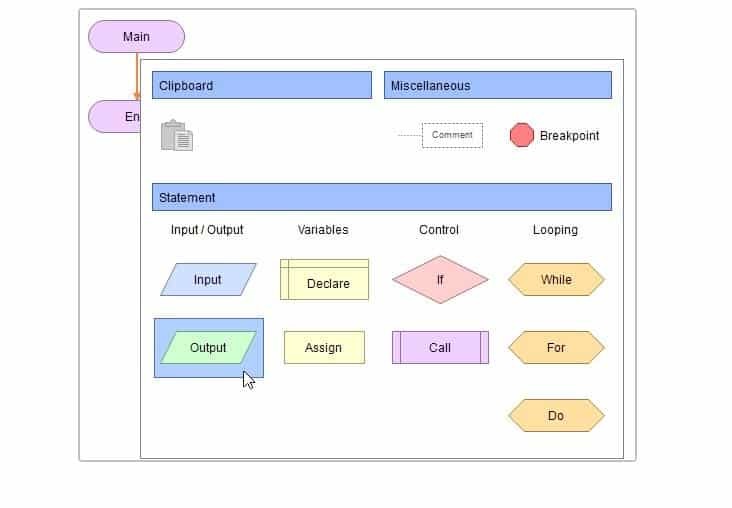WineBottler packages Windows-based programs snugly into OS X app-bundles. No need to install emulators or operating systems - WineBottler uses the great open-source tool Wine to run the binaries on your Mac. Flowgorithm newbie closed Ask Question Asked 2 days ago. Active yesterday. Viewed 27 times 0. This question needs details or clarity. It is not currently.
Flowgorithm is one of the visual programming tools available today.
Positive:
Flowgorithm is one of the visual programming tools available today. Find the best herbal remedies for you. Submitted 16 days ago by cprice0219. This flowchart must use while loops to validate the input. Flowgorithm is a graphical authoring tool which allows users to write and execute programs using flowcharts. For example, if n = 6 print!! Flowchart for Rock paper scissors application -You can edit this template and create your own diagram.Creately diagrams can be exported and added to Word, PPT (powerpoint), Excel, Visio or any other document.
- visual programming, focus is more on the modelling on how to solve the problem than on the syntax of programing language like java, c# or python.
Negative:
- so far there is no way to read and write files

The figure below shows when execution is ongoing in slow speed. One can see where the execution is, both in the big flowchart and in the source code window (in this case Java). In addition, there is variable window (lower left) showing that 2 lotto numbers had been generated so far. The console window on the lower right is used for input and output operations.
The figure below is the clipboard copy of the flowchart in flowgorithm. The tool can also export in emf and svg formats.
Visual program file for lotto Hindi movie sawan ko aane do mp3 song free download.
This file is zipped. unzip in order to get the “Lotto.fprg” file.
Testing the java source
The generated java code worked well, as can be seen in the figure below. DrJava (portable) was used to compile and run the code. There was only 1 minor tweak needed (ie. one needed to initialize the NewNumber variable, see line “int NewNumber = 0;”)
Links
- Another similar tool is Raptor, but with different features (read/write files, some basic graphics)
To solve this problem we will take a variable sum and set it to zero. Then we will take the two numbers 10 and 20 as input. Next we will add both the numbers and save the result in the variable sum i.e., sum = 10 + 20. Finally, we will print the value stored in the variable sum.
Algorithm (in simple English)- Initialize sum = 0 (PROCESS)
- Enter the numbers (I/O)
- Add them and store the result in sum (PROCESS)
- Print sum (I/O)
In this question we are asked to find the sum of 5 numbers. So, we will take two variables - sum and count and set both of them to zero. The sum variable will store the result while the count variable will keep track of how many numbers we have read.
To solve this problem we will use the concept of loop. In loop or iterative operation, we execute some steps repeatedly as long as the given condition is TRUE. In this case we will keep reading the input till we have read 5 numbers.
So, we first initialize sum and count to zero. Then we will take the input and store it in a variable n. Next we will add the value stored in n to sum and save the answer in sum.
i.e., sum = sum + n
Then we will increment count by 1 and check if count is less than 5. If this condition is TRUE then we will take another input. If the condition is FALSE then we will print the value stored in variable sum.
Algorithm (in simple English)- Initialize sum = 0 and count = 0 (PROCESS)
- Enter n (I/O)
- Find sum + n and assign it to sum and then increment count by 1 (PROCESS)
- Is count < 5 (DECISION)
- if YES go to step 2
else
Print sum (I/O)
This problem is also solved using the loop concept. We take a variable count and set it to zero. Then we print 'Hello World' and increment count by 1.
i.e., count = count + 1
Next we check if count is less than 10. If this is TRUE then we again print 'Hello World' and increment the variable count. On the other hand if the condition if FALSE then we will stop.
Algorithm (in simple English)- Initialize count = 0 (PROCESS)
- Print Hello World (I/O)
- Increment count by 1 (PROCESS)
- Is count < 10 (DECISION)
- if YES go to step 2
else Stop
This problem can be solved in many ways so, we will encourage you to think and draw a flowchart for this problem using your imagination.
To log in to facebook account we first enter the facbook URL www.facebook.com in our browser like Google, Firefox, Safari, Internet Explorer etc. This request is sent to the facebook server and it responds by sending us the home page of facebook.
Next, we enter our registered Email ID and Password and click the Login button.
Then our login credential is checked. If it is correct, we are show our profile. On the other hand, if the login credential is wrong then an error occurs and we are prompted to re-enter our Email ID and Password.
Algorithm (in simple English)- Enter www.facebook.com in your browser. (I/O)
- facebook Home page loads (PROCESS)
- Enter your Email ID and Password (I/O)
- Is Email ID and Password Valid (DECISION)
if NO then
Log in error (PROCESS)
go to step 3
else
Display facebook Account (I/O)
Stop

The figure below shows when execution is ongoing in slow speed. One can see where the execution is, both in the big flowchart and in the source code window (in this case Java). In addition, there is variable window (lower left) showing that 2 lotto numbers had been generated so far. The console window on the lower right is used for input and output operations.
The figure below is the clipboard copy of the flowchart in flowgorithm. The tool can also export in emf and svg formats.
Visual program file for lotto Hindi movie sawan ko aane do mp3 song free download.
This file is zipped. unzip in order to get the “Lotto.fprg” file.
Testing the java source
The generated java code worked well, as can be seen in the figure below. DrJava (portable) was used to compile and run the code. There was only 1 minor tweak needed (ie. one needed to initialize the NewNumber variable, see line “int NewNumber = 0;”)
Links
- Another similar tool is Raptor, but with different features (read/write files, some basic graphics)
To solve this problem we will take a variable sum and set it to zero. Then we will take the two numbers 10 and 20 as input. Next we will add both the numbers and save the result in the variable sum i.e., sum = 10 + 20. Finally, we will print the value stored in the variable sum.
Algorithm (in simple English)- Initialize sum = 0 (PROCESS)
- Enter the numbers (I/O)
- Add them and store the result in sum (PROCESS)
- Print sum (I/O)
In this question we are asked to find the sum of 5 numbers. So, we will take two variables - sum and count and set both of them to zero. The sum variable will store the result while the count variable will keep track of how many numbers we have read.
To solve this problem we will use the concept of loop. In loop or iterative operation, we execute some steps repeatedly as long as the given condition is TRUE. In this case we will keep reading the input till we have read 5 numbers.
So, we first initialize sum and count to zero. Then we will take the input and store it in a variable n. Next we will add the value stored in n to sum and save the answer in sum.
i.e., sum = sum + n
Then we will increment count by 1 and check if count is less than 5. If this condition is TRUE then we will take another input. If the condition is FALSE then we will print the value stored in variable sum.
Algorithm (in simple English)- Initialize sum = 0 and count = 0 (PROCESS)
- Enter n (I/O)
- Find sum + n and assign it to sum and then increment count by 1 (PROCESS)
- Is count < 5 (DECISION)
- if YES go to step 2
else
Print sum (I/O)
This problem is also solved using the loop concept. We take a variable count and set it to zero. Then we print 'Hello World' and increment count by 1.
i.e., count = count + 1
Next we check if count is less than 10. If this is TRUE then we again print 'Hello World' and increment the variable count. On the other hand if the condition if FALSE then we will stop.
Algorithm (in simple English)- Initialize count = 0 (PROCESS)
- Print Hello World (I/O)
- Increment count by 1 (PROCESS)
- Is count < 10 (DECISION)
- if YES go to step 2
else Stop
This problem can be solved in many ways so, we will encourage you to think and draw a flowchart for this problem using your imagination.
To log in to facebook account we first enter the facbook URL www.facebook.com in our browser like Google, Firefox, Safari, Internet Explorer etc. This request is sent to the facebook server and it responds by sending us the home page of facebook.
Next, we enter our registered Email ID and Password and click the Login button.
Then our login credential is checked. If it is correct, we are show our profile. On the other hand, if the login credential is wrong then an error occurs and we are prompted to re-enter our Email ID and Password.
Algorithm (in simple English)- Enter www.facebook.com in your browser. (I/O)
- facebook Home page loads (PROCESS)
- Enter your Email ID and Password (I/O)
- Is Email ID and Password Valid (DECISION)
if NO then
Log in error (PROCESS)
go to step 3
else
Display facebook Account (I/O)
Stop
Note!
As there are many ways to solve a given problem so there are many ways to draw a flowchart.
